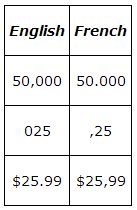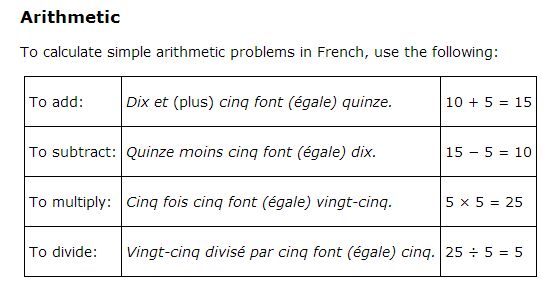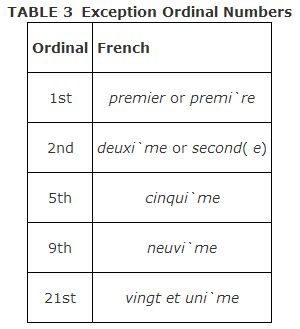The French cardinal numbers, those used for counting, require you to use math skills once you get past 69. The number 70 is formed by adding 60 + 10, 71 is 60 + 11, and so on until 80 is reached. The number 80 is 4 × 20, while 81 is 4 × 20 + 1, and so on through the number 99.
Consult Table 1 for a list of French cardinal numbers that you should know.

Note the following about cardinal numbers:
The conjunction et (and) is used only for the numbers 21, 31, 41, 51, 61, and 71. In all other compound numbers through 99, et is dropped and a hyphen is used.
Before a feminine noun, un becomes une.
- vingt et un garçons(21 boys)
- vingt et une filles (21 girls)
For quatre‐vingts (80) and the plural of cent (100) for any number above 199, drop the ‐s before another number, but not before a noun. The ‐s is also dropped when these numbers are used in an ordinal sense (for example, to express page or address numbers and dates).
- quatre cent vingt dollars (420 dollars)
- quatre cents dollars (400 dollars)
- quatre‐vingt‐dix‐neuf euros (99 euros)
- quatre‐vingts euros(80 euros)
- à la page deux cent (on page 200)
- dans la rue quatre‐vingt (on 80th Street)
- pendant l'année neuf cent (during the year 900)
Un is not used before cent (100) and mille (1,000).
- mille personnes (1,000 people)
Mille doesn't take ‐s in the plural.
- cinq mille dollars (5,000 dollars)
Mille is generally written mil in dates until 1999:
- Je suis né en mil neuf cent quarante‐sept. (I was born in 1947.)
Starting with the year 2000, the date is written as follows:
- Ma fille est née en (l'an) deux mille. (My daughter was born in 2000.) When another number is added after 2000, mil is generally preferred to mille.
- Mon fils est né en (l'an) deux mil( le) deux. (My son was born in 2002.)
To express numbers between 1,000 and 9,999, you can avoid using mille and simply use cent where it is more convenient.
- mille neuf centsor dix‐neuf cents (1,900)
In numerals and decimals, the French use commas where Americans use periods, and vice versa:

Numbers and nouns of quantity
Nouns that are used to express a quantity or a measure are followed by de + noun. The cardinal numbers million and milliard, as well as other nouns of number, follow this rule.
- un million de touristes(a million tourists)
- onze milliards de gens(11 billion people)
- deux boîtes de céréales (2 boxes of cereal)
- un tas de papiers (a pile of papers)
Refer to Table 2 for common nouns of number and quantity.


Ordinal numbers
In French, most ordinal numbers (those used to show rank or placement) are formed by adding ‐i`me to the cardinal number. When the cardinal number ends in a silent e, that vowel is dropped before adding the ordinal ending ( quatri`me is “fourth,” onzi`me is “eleventh,” and so on). Consult Table 3 for exceptions to the rule.

Note the following about ordinal numbers:
Premier and premi`re are abbreviated as follows:
All others ordinals get a superscript e.
Ordinal numbers agree in number and gender with the nouns they describe. Premier (premi`re)and second (seconde) are the only ordinal numbers that have a feminine form.
- le premier acte (the first act)
- la premi`re pi`ce (the first play)
- les premi`res années (the first years)
- la Seconde Guerre mondiale (the second World War)
- les vingt et uni`mes anniversaires (21st birthdays)
Premier is used only for the first in a series. For 21 to 71, uni`me is added after the conjunction et to express first, and it must agree in number with the noun it modifies.
- la cinquante et uni`me année (the 51st year)
Second(e) is generally used in a series that goes no higher than two.
Use le or la before huit/huiti`me and onze/onzi`me. There is no elision.
- le huiti`me anniversaire(the 11th birthday)
- le onze juillet (July 11th)
In French, cardinal numbers precede ordinal numbers.
- les deux premi`res personnes (the first two people)
